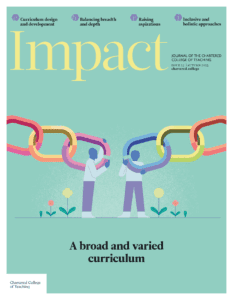Journeys, buildings and rivers, making a mess and getting lost: The curriculum metaphors we teach by
Written by: Caroline Godfrey

7 min read
CAROLINE GODFREY, ASTON UNIVERSITY, BIRMINGHAM, UK
Why curriculum metaphors are important and why they are important now
Some readers may be surprised to encounter an evocation of the importance of metaphors in a journal dedicated to the work of practising teachers. Metaphors, however, have been found to hold enormous power when it comes to shaping our beliefs and perspectives and they can unconsciously mould our views on a whole range of social and cultural issues, such as mental health, academic research and gender policy, to name but a few (Adams, 2023). Thibodeau and Boroditsky (2011), for example, demonstrate that news reports utilising metaphors can subtly affect the way in which readers reason about the methods that should be employed by authorities to deal with crime. Exposure to the ‘crime as a beast’ metaphor led participants in Thibodeau and Boroditsky’s (2011) study to propose catching and incarcerating criminals and implementing harsher enforcement laws. Alternati
Join us or sign in now to view the rest of this page
You're viewing this site as a guest, which only allows you to view a limited amount of content.
To view this page and get access to all our resources, join the Chartered College of Teaching (it's free for trainee teachers and half price for ECTs) or log in if you're already a member.
- Adams PJ (2023) Monster Metaphors: When Rhetoric Runs Amok. London: Routledge.
- Applebee AN (1996) Curriculum as Conversation: Transforming Traditions of Teaching and Learning. Chicago: University of Chicago Press.
- Badley K and Van Brummelen H (2012) Metaphors: Unavoidable, influential and enriching. In: Metaphors We Teach By: How Metaphors Shape What We Do in the Classroom. Eugene, OR: Wipf and Stock, pp. 1–15.
- Bleiman B and McCallum A (2022) EMC response to Ofsted curriculum research review: English. In: EMC Blog. Available at: www.englishandmedia.co.uk/blog/emc-response-to-ofsted-curriculum-research-review-english (accessed 22 July 2025).
- Charteris-Black J (2004) Corpus Approaches to Critical Metaphor Analysis. Basingstoke: Palgrave Macmillan.
- Cliff-Hodges G (2010) Rivers of reading: Using critical incident collages to learn about adolescent readers and their readership. English in Education 44(3): 181–200.
- Department for Education (DfE) (2025) Curriculum and Assessment Review: Interim report. Available at https://assets.publishing.service.gov.uk/media/67e6b43596745eff958ca022/Curriculum_and_Assessment_Review_interim_report.pdf (accessed 8 April 2025).
- Eaglestone R (2019) Literature: Why it Matters. Cambridge: Polity Press.
- Goatly A (2002) Conflicting metaphors in the Hong Kong Special Administrative Region educational reform proposals. Metaphor and Symbol 17(4): 263–294.
- Leat D (2023) From the editor. Impact 18: 1–4.
- Macken-Horarik M (2011) Building a knowledge structure for English: Reflections on the challenges of coherence, cumulative learning, portability and face validity. Australian Journal of Education 55(3): 197–213.
- Ofsted (2005) English 2000–05: A review of inspection evidence. Available at: https://dera.ioe.ac.uk/id/eprint/5476/1/English%202000-05%20a%20review%20of%20inspection%20evidence%20%28PDF%20format%29.pdf (accessed 8 April 2025).
- Ofsted (2009) English at the crossroads: An evaluation of English in primary and secondary schools, 2005/8. Available at: https://dera.ioe.ac.uk/id/eprint/298/1/English%20at%20the%20crossroads.pdf (accessed 8 April 2025).
- Ofsted (2011) Excellence in English: What we can learn from 12 outstanding schools. Available at: https://dera.ioe.ac.uk/id/eprint/3007/1/Excellence%20in%20English.pdf (accessed 8 April 2025).
- Ofsted (2013) Moving English forward: Action to raise standards in English. Available at: https://assets.publishing.service.gov.uk/media/5a7b44bc40f0b66a2fc0648b/110118.pdf (accessed 8 April 2025).
- Ofsted (2022) Research review series: English. Available at: www.gov.uk/government/publications/curriculum-research-review-series-english/curriculum-research-review-series-english (accessed 8 April 2025).
- Ofsted (2024) Telling the story: The English education subject report. Available at: www.gov.uk/government/publications/subject-report-series-english/telling-the-story-the-english-education-subject-report (accessed 8 April 2025).
- Thibodeau PH and Boroditsky L (2011) Metaphors we think with: The role of metaphor in reasoning. PLoS ONE 6(2): 1–11.
0
0
votes
Please Rate this content
Please login to comment
0 Comments
Oldest
Newest
Most Voted
Inline Feedbacks
View all comments










